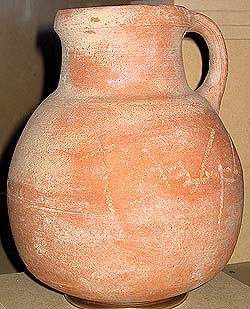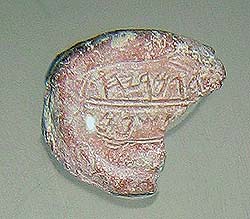



|
 |
LIFE IN FIRST TEMPLE TIMES
When Writing Speaks
In the early days of the form of writing referred to by experts as
Paleo-Hebrew, scribes used the script used earlier by the Phoenicians
and other neighbouring peoples. But starting in the 6th century BCE, after
Jerusalem fell to the Babylonians and the Judeans were sent into Exile,
the Judeans adopted the Aramaic script of the conquerors, which
they eventually developed into the square Hebrew script
used to this day.
Writing was initially the prerogative of the royal administration and
scribes but soon became widespread. Hebrew script was written on papyrus,
stone and ostraca-potsherds used as writing surfaces, mainly
for notes.
 |

Jug with inscription.
Collection of Israel Antiquities Authority, exhibited at The Israel Museum, Jerusalem
Photo © The Israel Museum, by Dr. Jean-Luc Pilon, Canadian Museum of Civilization
|
7th century BCE
Gemariah, son of the scribe Shaphan
In about 604 BCE, the family of Gemariah hid the prophet Jeremiah to
protect him from King Jehoiakim's wrath. What was he so angry about?
Shortly beforehand, according to his account in the Bible, Jeremiah
received divine instructions to warn Jehoiakim that the Kingdom of
Judah would soon fall. But it was a rather risky assignment, in those
days, to be the bearer of such bad tidings! Jeremiah dictated the Lord's
message to the scribe Baruch and had him deliver it in his stead.
It was then that Baruch-in the chamber of Gemariah son of Shaphan
the scribe...read the words of Jeremiah from the scroll to all the people.
Jeremiah 36:10
Twenty years after this dire prediction, the Kingdom of Judah did in
fact fall into the hands of the King of Babylon.
 |

Seal impression on clay.
Collection of Israel Antiquities Authority, exhibited at The Israel Museum, Jerusalem
Photo © The Israel Museum, by Dr. Jean-Luc Pilon, Canadian Museum of Civilization
|


|
 |







